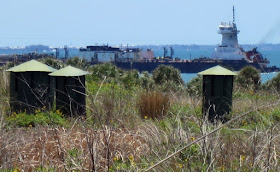 |
| Fort De Soto in Florida gives visitors a view of immense coastal defense mortars. |
"I don't think there was much there to begin with," she added.
But as far as I was concerned, our visit to Fort De Soto Park at the entrance to Tampa Bay was full of historical treasure.
Her opinion might have been justified if you were expecting a moat and castle walls. But Fort De Soto, built around the time of the Spanish-American War, is invisible from most angles — as it was designed to be.
 |
| Big 12-inch mortars were hidden in pits but could lob armor piecing shells onto the decks of warships |
Meanwhile, the massive 12-inch mortar barrels inside the pits would lob shells almost straight upwards to crash down on the lightly armored decks of the approaching battleships.
That was the theory, anyway. The eight guns of Battery Laidley at Fort De Sota were never fired in anger (and only four of them remain at the fort today).
 |
| Mortars could fire shells weighting 800 to 1,046 pounds. |
Hitting a moving target like a ship with a lobbed shell is obviously difficult, but these monsters would have had to hit a battleship the size of the Maine only once to be devastating.
Range was 6.8 miles, but a problem was that the mortars couldn't hit anything that was closer than 1.25 miles. Fast-firing 15-pounder guns were in position near the beach to deal with close, and fast moving targets.
Battleships did not remain the size of the Maine long, and Fort De Soto was obsolete before World War I began. The Army finally moved out in 1923, defeated by the hoards of mosquitoes.
Civil authorities eventually got those under control, giving Pinellas County a park with lovely beaches and one very well preserved fortress.
But 12-inch mortars like those at Fort De Soto did fight for the United States and, incredibly, it happened in World War II, after they had long been antique technology.
 |
| Photo on display at Fort De Soto shows two 12-inch mortars firing, with their shells visible in the air. |
It's one of the stories Doug's Dad did tell him, and it is detailed in Doug's memoir, Stories My Father Never Finished Telling Me.
 |
| Mortars being fired with lanyards. The guns could also be fired electrically from a buried "Firing Room" (surely a safer alternative). |
 |
| Two mortars remain in each of the two gun pits at Fort De Soto. Originally there were four guns in each pit but with 12 men loading and aiming each, congestion was a problem. |
 |
| Observation posts sent target directions to the Relocating Plot Room, which calculated gun settings and telephoned them to twin Data Booths. |
 |
| Fortified Data Booths displayed aiming information to the gunners by sliding out wooden slats. |
 |
| Where's the fort? It's the other side of that artificial hill. Concrete slabs on the beach are collapsed remains of a battery for two fast-firing 15-pounder guns. |

Very interesting. I had read of the guns at Corregidor, but did not know that any others of that type existed. Thanks for the info.
ReplyDeleteNeat article.
ReplyDelete